Mega May Madness: Madou Monogatari I
By Mento 0 Comments
For May 2022's "May Madness" feature I'm just playing a bunch of Sega Mega Drive / Genesis RPGs that caught my eye after researching for the Mega Archive blog series. You can see how well I'm doing by visiting the first entry, here.
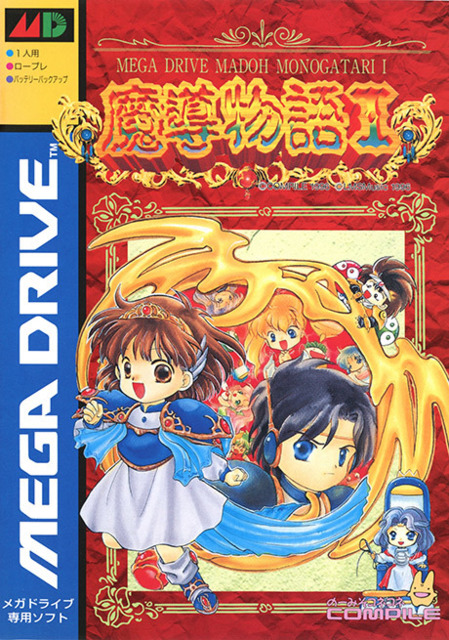
Another odd pick for today, but such is the result of my weird areas of interest. Madou Monogatari I is a first-person dungeon-crawler from erstwhile shoot 'em up experts Compile, and follows the adventures of a precocious witch tot named Arle Nadja as she makes her way through a world filled with unusually cute creatures and any number of magically-inclined rivals. There were originally three Madou Monogatari games made for the Sega Game Gear, each taking a third of the original MSX game and expanding them, and this Mega Drive game is an adaptation of the first that made some significant changes to the gameplay and visuals in preparation of it moving up to the big leagues. With its release date of March 1996 it is also, entirely coincidentally seeing as we're close to the end of Mega May Madness, the very last commercially released Mega Drive game... at least in Japan anyway: the system still saw support in the US, Europe, and Brazil as late as 1998. Hard to say if the game's technological coup - that every player spell, NPC, and enemy introduced itself with a voiced sound sample - still wowed anyone two years into the 32-bit era where floating dudes wearing gas masks could hold entire conversations with you.
Yes, yes, I am also conspicuously avoiding the elephant in the room. The Madou Monogatari series and its cute little colorful slime jobbers, collectively known as Puyo, were the basis for the much more renowned and celebrated Puyo Puyo franchise of blob-stacking puzzle games. Many of the characters introduced in Madou Monogatari would later be repurposed as opponents for Arle to fight one after the other for the story modes of those games; it's kinda nice to see a few of them making their first appearances here, with the context of who and what they are beyond "being slightly better at stacking slimes than the previous guy." For as tough as Madou Monogatari I could be, I think I had an infinitely better shot at completing it than I did trying to master setting up so many Puyo like dominoes.
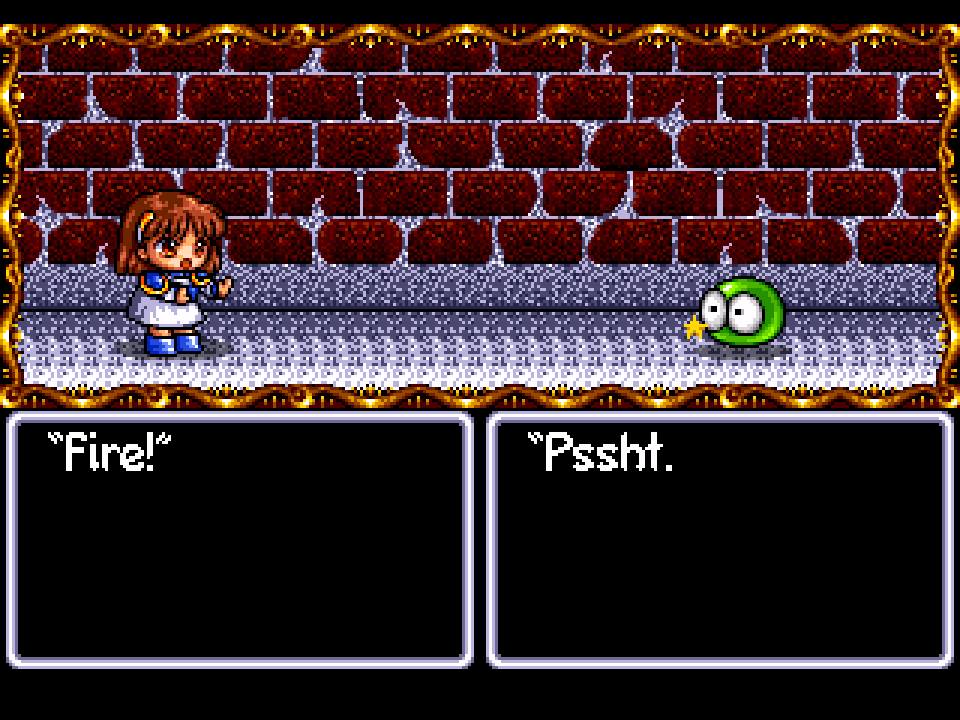
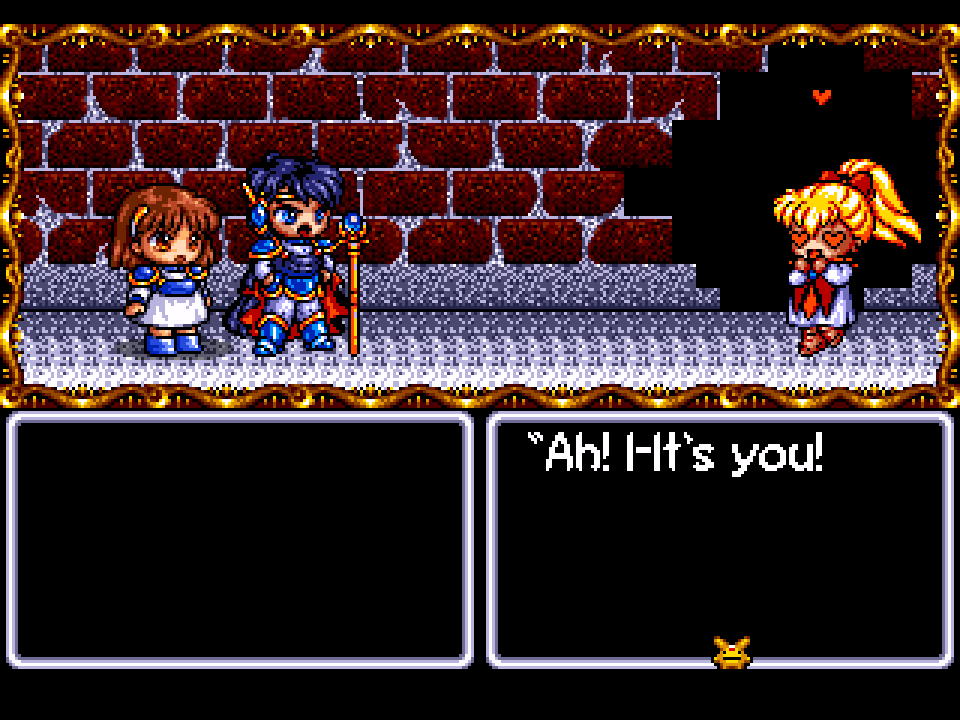
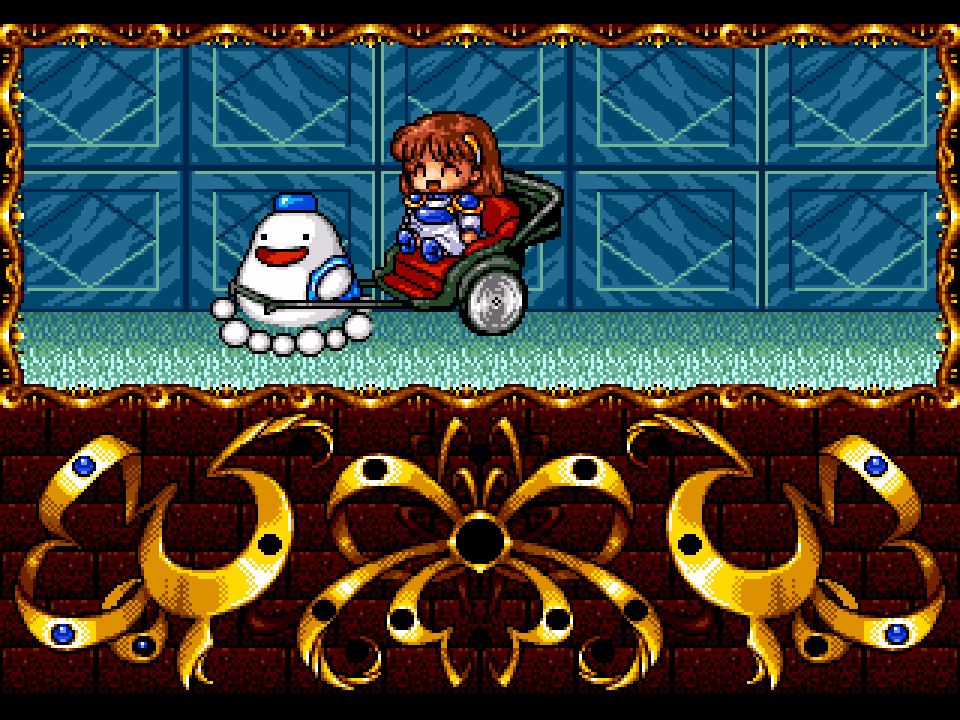
I really have a lot to talk about with Madou Monogatari besides its backstory though. Let's start with the big gameplay switch it undertook on its journey from the Game Gear to the Mega Drive: in the original version, whenever you randomly encountered an enemy while exploring the magical tower (I should mention here that Arle's climbing this thing as an exam to graduate from Magical Kindergarten; I think all I had to do to graduate kindergarten was identify which shape was a circle without crapping myself) you entered a turn-based fight where you flung spells back and forth. Arle does have a physical attack of sorts - she whacks foes with one of those harisen paper fans - but as a witch her magic is far more potent: most battles involve using basic attack spells that don't cost mana, like her fireball and ice storm (important to know which element your foe is weakest against), while saving her reserve of mana for useful utility spells like healing or buffs. In the Mega Drive version, rather than a turn-based structure the player and their opponent fight in real-time: spells must be cast by holding the A-button to enter the spell-casting mode and while in there quickly tapping out the D-pad combination that corresponds to the spell you want. Here, the basic fireball is a full radial starting with up and going counter-clockwise, while ice storm is the same but starting down and going clockwise. Healing is a simple down, down, up, up combination and other spells are either more or less complicated based on their strength and purpose. Spells are cast as quickly as you can cast them; this is where being good at Street Fighter really comes in useful, beyond I guess making millions at Evo. To ensure you don't have to memorize entire movelists like you're planning to show off fatalities at the local laundrette's Mortal Kombat cabinet, this input system has been relatively simplified: there's only a handful of spells that you'll learn at infrequent intervals and you'll be relying on the two basic offense spells for combat for most of the game. Notably, on the utility spell side, there's a Warp spell that teleports you to the same square on the map just one floor above; there's multiple instances where you'll be able to enter an otherwise inaccessible room this way, and more where determining where to cast it is absolutely necessary to make progress.
The Warp spell is just one drop in the ocean with regards to how imaginatively and circuitously structured the game's central dungeon can be, though. While it doesn't have the full array of weird traps and obstacles a typical Dungeon Master-derived game might - there's no weighing down pressure pads or anything too technical like that - it does have its share of intriguing environmental riddles to solve. A room where you slide about without stopping until you hit a wall presents something of an impassable dead end, at least until you find a portable wall with which to create your own stopping points. There's two pairs of floors that are linked with multiple ladders, as you go up and down many times in order to fully explore both. A floor filled with mirrors where there's certain panes that can be broken to make new passages once you figure out the trick to identifying them. There's even a subterranean area of the dungeon which I almost missed entirely: you need to follow the right breadcrumb of clues to figure out a way down there.

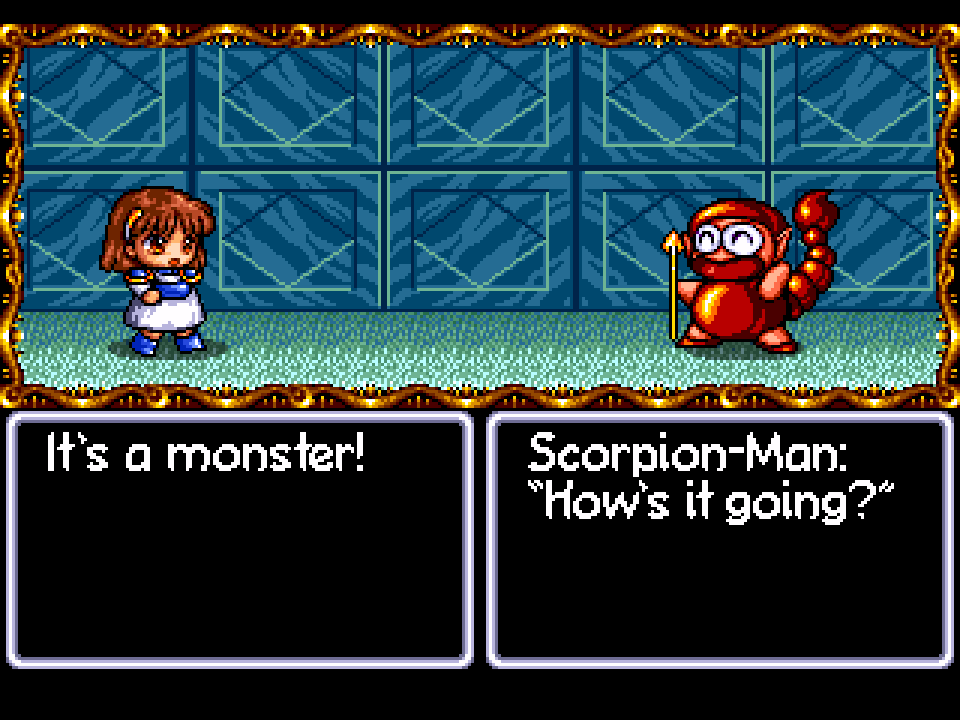
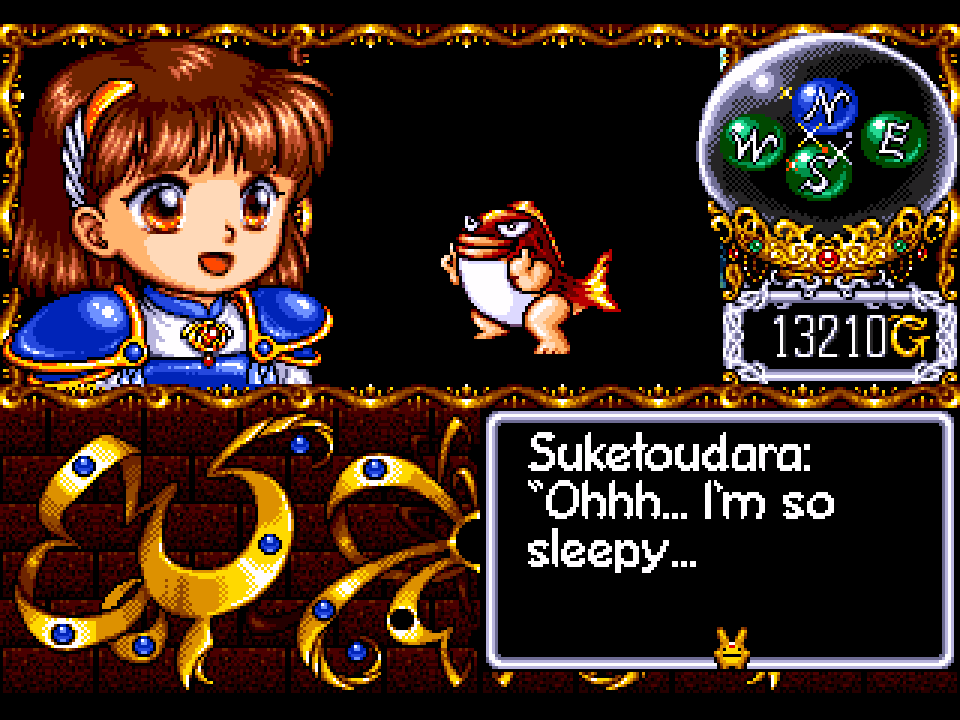
However, this isn't even where the main thrust of the game's puzzles are found. You see, any exam traditionally has a whole bunch of questions for you to answer: these appear throughout the dungeon as green signs on walls, each providing a specific command to follow. Some are simple enough: cast this spell (provided you've learned it), turn around and walk into that wall (kinda cruel), or sit still for ten seconds. Others require that you have a certain item which you then feed into a slot: they might tell you what it is straight up, or they'll give you a hint that could require interfacing with the game's "item fusion" crafting vendor (a fish named Fufufu, named for his creepy laugh). One even asked me for the gem that was September's birthstone, and I'll admit I had to look that one up (hint: it's the blue one). There are forty of these puzzles in total and there's no immediate rewards for completing them either, except that failing the exam even after beating the final boss and escaping the tower is still a possibility. (Other factors that contribute to your exam score: finding all the treasure chests (there's forty of those too) and helping NPCs when they ask for it. The game at least informs you about the puzzles and chests contributing to the exam the moment you start; they could've totally gone without telling you about these extra conditions until you're staring at the bad ending, like Sonic the Hedgehog and its Chaos Emeralds.)
The game's presentation is sterling, especially for the Sega Mega Drive. The music's catchy (even when it's being weird and warbly because Arle is poisoned or something), the voice clips do sound pretty good coming out of the Mega Drive sound chip, every character and enemy has a pleasingly adorable design (even the ghouls are moé), and while dungeons in games of this genre are almost invariably a bunch of blank walls there's at least some variety to their designs as you ascend the tower. The aforementioned floor of mirrors will show Arle's reflection whenever you're facing one, which is one cute touch in a game replete with them. In tandem with its simple visual charms, the game's interface is considerably scaled back to suit the kid-friendly approach it's going for. There are no visible stats in the game; instead, characters emote about their current health and magic conditions which roughly correspond to certain percentages ("Sticking in there, doing my best!" is around 50% health, for instance) as well as react to how hard the last spell hit (an "Ow! That hurt!" means you might want to keep an eye on Arle's ongoing commentary about her condition). It creates a layer of abstraction that might not to be to everyone's taste, but you always at least have a sense of how you're holding up if nothing determinate. Even outside of battle, Arle's portrait is always highly visible taking up almost the entire left side of the screen as it does, and her expression really tells you everything you need to know about how over this shit she happens to be at the present moment.

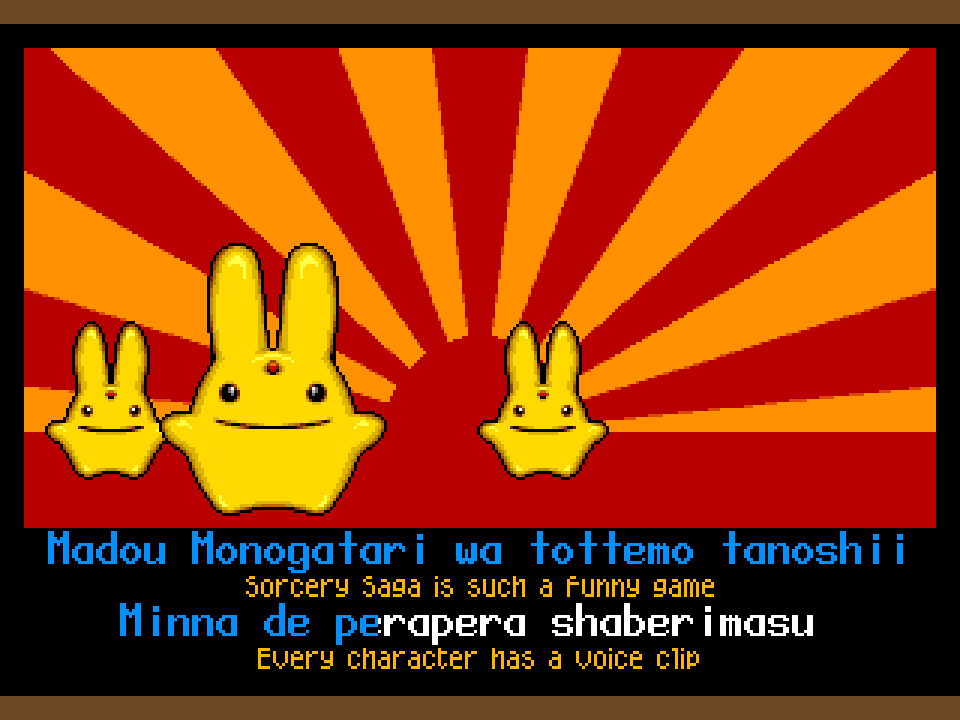
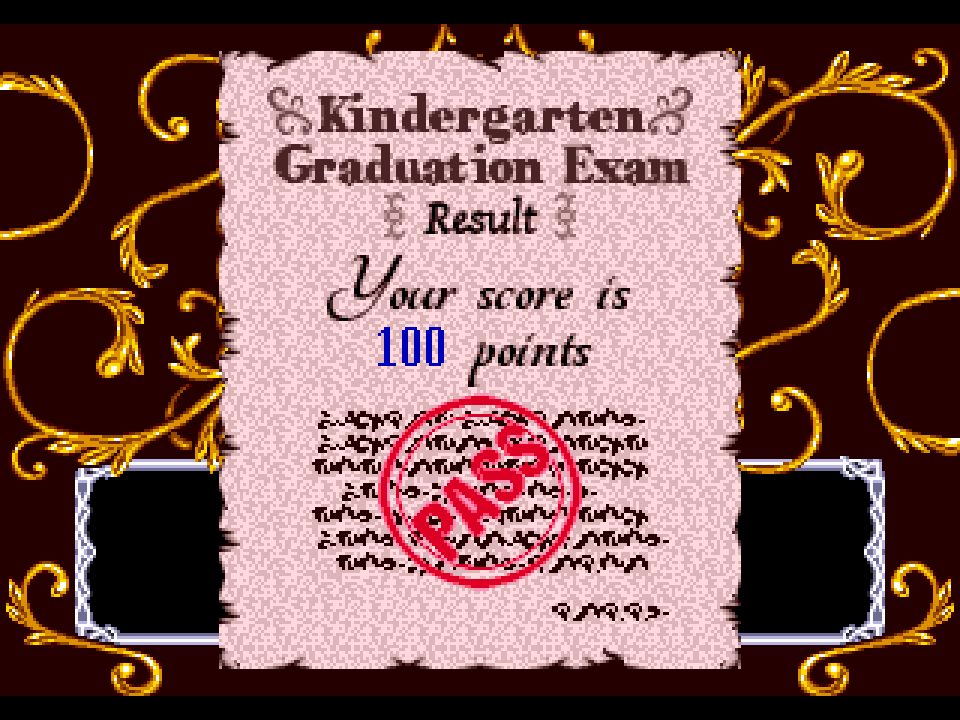
Between solving all these puzzles and setting fire to enemies with rapid-input Street Fighter commands, I had an unexpectedly good time with Madou Monogatari I. It certainly has its issues mostly regarding its age - there's simply way too many random encounters, even for as fast as they can be resolved once you have a few levels on you and are nuking monsters with a single fireball - but for the most part it understands what makes these first-person dungeon-crawlers tick: an ever-present sense of mystery and danger, never knowing what lies around the next corner or beyond that transition to the next floor, with a lot of conundrums and secrets to chew on as you press forward down those corridors. I had a running notepad file open the entire time I was playing, both a necessity for logging all the puzzles I couldn't currently solve as well as jotting down the many hints I received, and that's usually the encouraging mark of a RPG you have to pay attention to, rather than one that might be a little too easy or too linear for its own good. Thankfully, it's still a late enough RPG that it had an auto-map feature, which is probably where I draw the line these days: if I have to bust out my pad of graph paper to play a video game in 2022 that's almost certainly a bridge too far. I might recommend giving it a shot if you have an affinity for cute RPGs, circle motions, dungeon-crawlers, long lost Mega Drive obscurities, or just the whole Madou Monogatari/Puyo Puyo franchise in general.
Rating: 4 Ristars out of 5.
